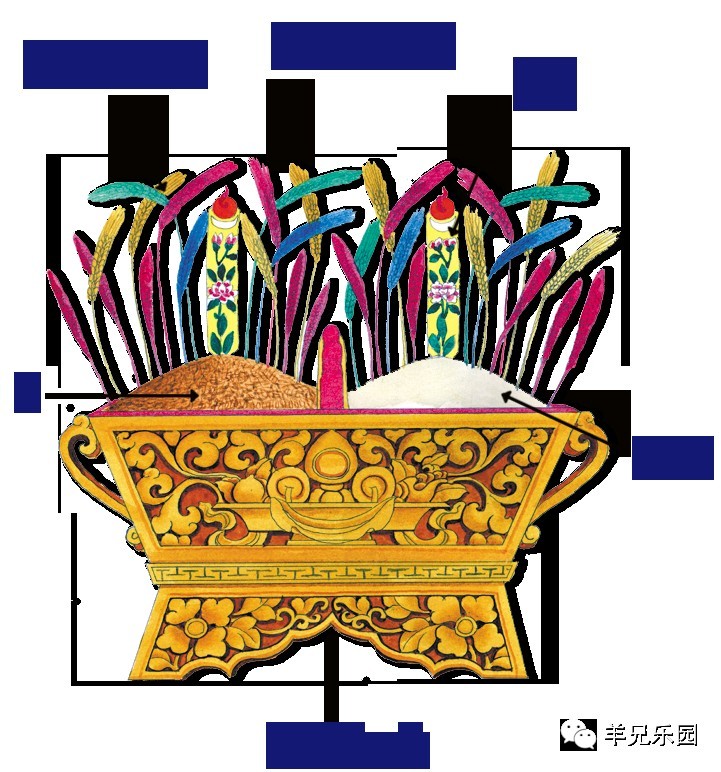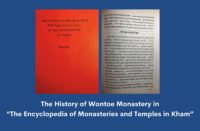
High Peaks Pure Earth would like to wish all readers Losar Tashi Delek! February 19, 2015 marks the first day of Tibetan New Year (Losar), the Tibetan year is 2142, the Wood Sheep year.
Back in 2010, we posted an informative piece about the “The Tradition of ‘Gu-thug’ Before Losar” and today’s post is similarly informative about the tradition of offering roasted barley and butter at Losar. The piece below was posted to the app WeChat by a Tibetan called “TibetSheep” on January 20, 2015 and circulated widely.
Again, our thanks goes to Palden Gyal for the translation from Tibetan to English.
Chemar: The Auspicious Offering of Roasted Barley and Butter
Even though it is difficult to ascertain with historical records the origin of the tradition of the auspicious offering of mixed roasted barley and butter, quite unanimously, Tibetan oral histories have it that like the rituals of invocation and offerings to divine spirits and local gods it was one of the requisite articles of rituals in Bon religion of Tibet. Given that this tradition of offering of roasted barley and butter (Chemar) was observed during the reign of the 33rd Tibetan King Songtsen Gampo in the seventh century, it is likely that the tradition was originated and prevailed some time prior to his dynasty. It might not have had been a very luxurious tradition of making offerings as it is today. Tibetan farmers and nomads have a tradition of putting pieces of butter on plates of barley and butter (the ingredients include the three sweets: sugar, honey, and molasses, and the three white things: curd, milk, and butter), and I think this was how it was observed initially. Today Chemar is an emblem of celebration and prosperity, and it plays an essential role in the celebration of the traditional Tibetan New Year as a token of good fortune (Losar). It is also prepared for other celebratory ceremonies, religious or secular, like during enthronement ceremony of reincarnated Rinpoches, housewarming parties, weddings, birthdays and etc. In olden times, Tibetans used to offer each other bundles of ears of corn ear of grain as a symbol of celebration and good fortune during Losar and other important occasions, however, it evolved to a tradition of offering it in fixed measures of grains in one trencher embellished with a salt stone on top and roasted barley in another decorated with three to five flakes of butter (28 kg in each), and the two trenchers were held by two people during the proceedings of a celebration. Gradually, it evolved into a single and joined trencher carved or painted on the sides with various ornamental and felicitous artwork such as the Eight Auspicious Symbols, the Eight Auspicious Articles, the Seven Precious Gems, or the two snow-lions holding the precious gem.

The right side of the trencher (‘bo) is filled with parched wheat and the left with roasted barley, and there is a birch tablet inscribed with butter the four friends (allegory of cooperation) or other ornamental and auspicious illustrations that is erected on it. The auspicious offering of roasted barley and butter is usually prepared as a necessary element during the celebration of the Tibetan New Year and also during celebrations of other auspicious and important traditional festivals. As for Losar, it symbolises the herald of good fortune, success and happiness to all sentient beings in the new year and in the future ahead. While offering Chemar along with a cup of Tibetan barley or rice wine (chang), the person offering it greets by saying “Tashi Delek,” and the recipients salute and respond: “Tashi Delek Phunsum Tsok, Ama Pakto Kukham Sang, Tendu Dewa Thobpar Shog, Gongni Gongdu Phelwar Shog,” which means, “Auspicious goodness and abundance to you, may you be healthy and peaceful, may you find eternal peace and happiness, and may your pursuit of peace and happiness flourish day by day.” During celebrations other than Losar, both the giver and receiver of Chemar greet each other by saying “Tashi Delek.” The tradition of displaying the Losar feast with a sheep-head decorated with flakes of butter was also evolved into a convention that it must be consumed as a necessary formality of the custom.

In Chemar, one side of the trencher (‘bo) is filled with grains of wheat or parched wheat, and it is considered auspicious or a good omen. In olden times, the tradition of writing a swastika with wheat during the enthronement of Kings or Chieftains was considered as a representation of stability and security. Generally, in tantric rites and rituals, monasteries almost exclusively use grains of barley. And the use of saffron crocus and saffron colored grains in rituals of consecration and good fortune are considered auspicious. The chief significance and symbol of Chemar is that it represents the main produce of Tibetan nomads and farmers. Tibetan farmers’ main produce is grain, and roasted barley (tsampa) is the staple food. Milk, butter and curd are the major produce of Tibetan nomads, but butter is considered as the chief produce. As a result, butter and roasted barley represent the foremost produce and staple food of all Tibetans. The convention of sprinkling barley wine is also an age-old custom developed and attached to the tradition of Chemar.





Follow Us!